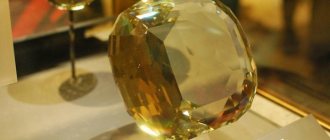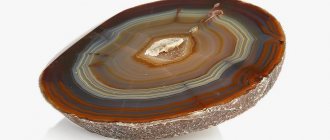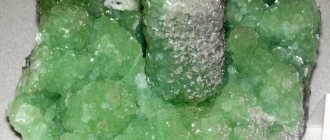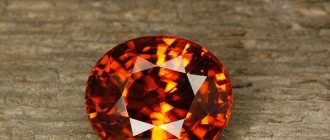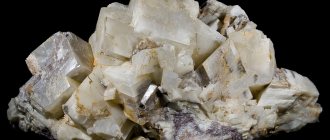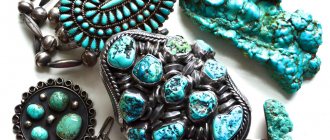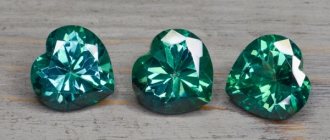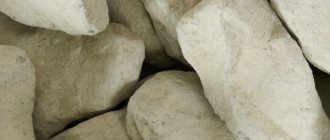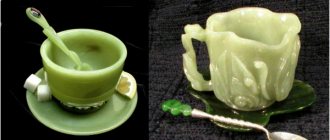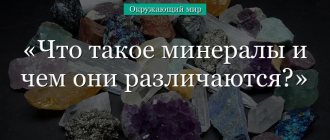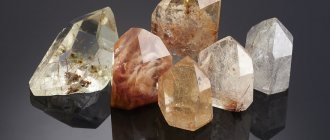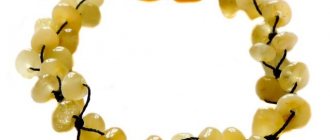Topaz is a stone of extraordinary beauty, which is distinguished by its variety of colors. Although there are more expensive gemstones in the world, topaz, a semi-precious stone, has been and remains the top seller. Mainly because the price is quite affordable. In addition, there is a real opportunity to purchase a real natural specimen, which, if worn correctly, will delight its owner for many years.
In this article we will take a detailed look at what topazes are, get acquainted with the scope of their use, and find out what the properties of the stone are. Of course, it is impossible to learn everything about topaz in a short period of time, but getting to know it better will be both interesting and useful.
Story
Why is this stone called topaz?
There are 2 versions about the origin of the name: 1. The gem was named by sailors in honor of the island of Topazios in the Red Sea, near which they were shipwrecked. The historian of Ancient Rome Pliny the Elder wrote that the mineral was mined there. But later it turned out that chrysolites were discovered there. So the second version seems more correct.
2. “Topaz” translated from Sanskrit means “flame, fire, heat.” Most likely, the first gems discovered were golden-orange or red in color.
Since ancient times, topaz has been of considerable importance to humans. Archaeologists have found jewelry and ritual objects made from this stone. During the first excavations in the Ural Mountains, women's jewelry and tools made from this mineral were found. During the Renaissance it was very popular among the nobility. In Rus' he was known as a “heavyweight”.
Crystallographic characteristics
Syngony. Rhombic. 3L23PC
Crystal structure
The basis of the structure is a motif of Al octahedra, in which Al is surrounded by four O and two F or (OH) atoms. Octahedrons partly have common vertices (F), partly common edges (O - O). Between the octahedra there are isolated SiO4 tetrahedra. The O atoms of the octahedra simultaneously belong to the silicon-oxygen tetrahedra; F or (OH) are associated only with Al. An infrared spectrum of polarized light for topaz with significant (OH) content showed that the (OH) group is located in the (010) plane, and the angle between the O-H bond and the c axis is approximately 37°. The structure combines the densest cubic and hexagonal packaging of oxygen.
Class. Rhombic-bipyramidal D2h - mmm. Axle ratio. 0.528: 1: 0.955.
Place of Birth
There are a lot of deposits of this mineral on our planet. Particularly large ones are in Brazil. This is where the record-breaking stone weighs 5 tons . There are gems of all colors there. Red topazes are highly prized (they are called “Brazilian rubies”).
In Russia, multi-colored stones are mined in Transbaikalia (near Nerchinsk), in the Urals (their figurative name is “Ural diamonds”).
In Germany, colorless samples (called “Saxon diamond”) and wine-yellow samples are found.
Sri Lanka supplies the market with colorless topazes (“water sapphires”) and golden ones.
MORPHOLOGY
The crystals are common, usually rich in facets and often well formed. The crystal habit is rhombic-prismatic or meek-columnar. Sometimes large, crystals weighing up to 60-80 kg have been found. The faces of the prism are usually few in number, and the heads of the crystals are very varied and rich in faces; the faces of the prism often have rough vertical shading. Characteristic signs of natural dissolution appear on the heads of crystals in cone-shaped and nipple-shaped forms, and on the faces of prisms - in the form of negative tetragonal pyramids and grooves parallel to the elongation. Also parallel columnar coarse-crystalline intergrowths, cryptocrystalline “jasper-like” formations, radiant and thin-plate (pycnite) aggregates.
Description and physical properties
Topaz is a 2nd level semi-precious stone, but due to its beauty, demand and cost, it has been promoted to the precious segment. The composition is aluminum fluorosilicate. The chemical formula is Al2[SiO4](F,OH)2 .
This gem has the following properties:
- Hardness is high - 8 points on the Mohs scale . Despite this, it lends itself perfectly to jewelry processing.
- High density ( 3.49–3.57 g/cm3 ) and transparency.
- Topaz comes in various color shades or colorless. The coloring is usually clear, without haze. There are also “cat’s eye” effects.
- It is easily electrolyzed by friction and temperature changes, which causes a slight tingling sensation on the skin in people.
- Discolors when exposed to sunlight. Can restore color by lying in the dark.
- Heat treatment makes the color rich.
Artificial acquisition
Synthesized in different ways: by heating a mixture of Si02, Al2O3 (or aluminum silicates), HF and H2O to 500°; when heated in an autoclave a mixture of Na2SiFe, amorphous Al2O3, SnCl2 and water at a temperature of 500° and a pressure of 4000 kg/cm2 for 9 days (together with cryolite, chiolite and quartz), for 10 days under the same conditions - together with cassiterite, cryolite and a small amount of albite.
Diagnostic signs
Similar minerals. Phenakite, corundum, aragonite, datolite, beryl.
It differs from andalusite in its perfect cleavage along (001) (andalusite has prismatic cleavage), smaller angle of optical axes, sign and optical orientation; from sillimanite - weaker birefringence and a different direction of cleavage; from feldspar - greater density and hardness, higher relief, absence of twins and indirect extinction; from quartz - cleavage, hardness and density; from apatite - birefringence, well-defined cleavage; from zoisite, melilite and vesuvian - the absence of anomalous interference coloring.
Satellites. Associated minerals. Tourmaline, mica, beryl, rose quartz, fluorite, smoky quartz, feldspar, cassiterite, wolframite, etc.
Topazes: types and colors
This stone comes in a wide variety of shades due to its impurities and structure. It sometimes combines several colors at once - such minerals are called polychrome. In nature, yellow varieties of topaz are more common.
Colorless
White or silvery topazes are very common. Since their deposits are located close to the surface of the Earth, sunlight discolors them, turning them transparent.
It is the starting material for obtaining colored topaz.
It is similar to diamonds in terms of clarity, many facets and deep shimmers, therefore it is considered their affordable competitor.
Light blue, blue
These stones are rarely mined. Dark blue colors are often obtained through professional processing.
Minerals of dark blue shades are characterized by increased strength. Blue topaz is considered an example of sophistication and is highly valued by jewelers. The deficiency of natural topaz of a bright blue hue is compensated by the following technology: white minerals are irradiated, resulting in an inky color, which is lightened by heat treatment.
Irradiated specimens are kept under special conditions so that the radiation level becomes safe.
Trade names of blue and dark blue topazes:
- Sky Blue - light, not very expensive.
- Swiss Blue - with a darker shade. The price is higher.
- London Blue - dark blue and dark blue specimens. The darker it is, the higher it is rated. The cutting is done in a special way. London Blue is sometimes mistaken for sapphire.
Yellow
This mineral can have shades ranging from golden to brown. In the most valuable stones, rich yellow turns into blue.
There are many yellow topazes in India, where their medicinal properties were discovered.
Pink, red
These varieties are very expensive.
Red topaz cannot be counterfeited, as there is no technology that can make the crystals turn red while remaining transparent.
Green
This is a rare collectible mineral.
Its natural color, which is not typical for topaz, appears due to exposure to natural radiation.
The crystals have a soft, soft velvety sheen.
Haze and cloudiness indicate artificial processing, which reduces the value.
Black, purple
Deposits are rare. These minerals are difficult to cut. Black stones actually have a deep purple color and a haze inside, which is only noticeable in direct sunlight.
Smoky (rauchtopaz)
This stone is a variety of quartz, mistakenly classified as a member of the topaz family due to its smoky color. The name has become familiar in commerce and everyday life. The color range is from gray to brown.
"Mystic" topaz (rainbow)
Sparkles like a diamond. The crystal lattice creates multicolor. To become rainbow, you need processing, the technology of which was patented at the end of the 20th century. The colorless mineral is irradiated, after which it is coated with a microlayer of titanium or gold.
Imperial (Imperial, Royal)
There is no standard for its coloring. There is yellow, pink, and the orange-brown range is considered the standard. Very prized by jewelers.
Read also : Sapphire - a stone of magical flowering
Where and how are minerals used?
Of course, these gems find the widest use in jewelry. Jewelers often use various methods of enhancing stones to give them more attractive and vibrant colors. For example, stones that have no color are irradiated and can become very dark, even black. If a stone is exposed to a certain high temperature, it may turn bright blue or light blue due to certain chemical reactions occurring within the crystal lattice.
It is not always possible to determine whether a stone has been subjected to special treatment, even by contacting a qualified specialist. However, if the color of the topaz is too thick and bright, most likely, processing was carried out. It would be unfair to consider treated stones as “fake”. They look very beautiful and presentable, but their man-made shades may fade over time. Sometimes it is possible to re-process the stone, but a good jeweler will help determine whether this is realistic or not.
In addition to jewelry, topazes are used in various industries. However, the cost of the stone is quite high, which limits its use in this area. Most often, topaz is used as a grinding material for surfaces that are difficult to machine. This became possible due to the high hardness of the gem, which makes it second only to diamond and sapphire.
Medicinal properties
Topaz is one of the 12 powerful minerals with strong healing effects. This is an attribute of the ancient Indian practice of Ayurveda. The healing is enhanced if the jewelry frame is made of silver or yellow gold.
Helping on the mental and physical plane, this stone improves a person’s well-being.
In lithotherapy, the healing properties of the following topazes are used:
Colorless
- Increases the body's defenses.
- Helps strengthen the nervous system.
- Improves metabolism, thereby slowing down aging.
- Eliminates hormonal imbalances.
- Useful for insomnia.
- Beads protect against colds.
- Suitable for women's diseases, anemia.
Yellow
- Speeds up metabolism.
- It will help with throat and lung diseases if you wear a necklace.
- Calms nerves, stabilizes excessive emotions, suitable for people who have mental disorders.
- Relieves attacks of bronchial asthma when wearing the pendant.
Blue
- Has a beneficial effect on the thyroid gland if worn around the neck.
- Restores women's health.
- Resists depression.
- Helps with exacerbations of asthma.
- Lowers blood pressure.
Smoky
- It will help make your sleep healing, restful, and without frequent waking up.
- Increases resistance to stress.
- It is not recommended for particularly dreamy people, as it can put them into a trance and immerse them in a different reality.
Pink
- Helps overcome stress.
- Reduces grief.
It is necessary to take into account that these pebbles help increase appetite.
Scientists do not recognize the healing effects of the mineral, but many people prefer to use it as an addition to the treatment recommended by doctors.
Wine color
Wine topaz is another type of mineral that occurs naturally. At the same time, the shade of the stone can be different; topazes often have a greenish sheen; they can be transparent or golden. They say that this mineral helps protect the owner from adversity and disappointment.
A similar type of stone is found in nature; the mineral itself can be oval or even rectangular in shape. Light plays on the edges of the stone. But topaz is an evening stone and in artificial light it looks especially impressive.
The mineral protects the owner from such troubles:
- Lies and hypocrisy.
- Disappointments in life.
- Bad deeds.
Topaz loves those people who tell the truth. Therefore, if a person has bad thoughts or builds relationships with people on lies, then topaz will not help the owner. It will begin to expose the person, destroy his plans and bring the owner many problems.
Wine topaz can have a golden sheen, as well as a greenish tint; such stones are more expensive; they attract buyers not only for their beauty, but also for their rarity.
The mineral is suitable for both women and men; such jewelry can be considered a universal gift for people of any age. But girls are not given a mineral of this color; it is preferable to give them a pink-colored stone as a gift.
Magic properties
Since ancient times, people have been aware of the wonderful magical properties of topaz:
- In the East, it is considered a miraculous gem that promotes enlightenment of feelings and clarity of thoughts, comprehension of wise knowledge.
- Everywhere they believed that this stone was a protector from evil-minded people.
- It is believed that a talisman made from it helps in recognizing intrigue and deception, and in resolving complex cases. The mineral will only help an honest person with pure thoughts.
- Many take it on sea cruises, because they are sure that the crystal can calm the storm.
Talismans and amulets
Jewelry with topaz is also used as an amulet.
It is believed that wearing a stone can attract good luck and help achieve a favorable outcome in any matter.
The stone also helps to achieve success in professional activities, build a good career and get a money job.
As for individual professions, topaz patronizes scientists, entrepreneurs and travelers.
In addition, topaz amulets are used as a means to help restore the reproductive functions of the body, get rid of infertility and impotence.
A topaz talisman helps to calm down and soften anger, and it can influence both the person himself, restoring emotional stability, and those around him. Therefore, if someone has to communicate with an angry boss, the amulet will help smooth the situation a little.
It is believed that red and pink topaz can help in love affairs, awaken a romantic mood and make partners more attractive in each other's eyes.
Who is Topaz suitable for according to their zodiac sign?
According to astrology, it is suitable for all signs except Taurus and Aquarius, for whom it is better to prefer a different talisman. Agate, malachite, hyacinth, carnelian, emerald are compatible with Taurus, and hawkeye, citrine, aquamarine, and turquoise are compatible with Aquarius.
According to the zodiac sign, topaz stone is perfect for Scorpio and Gemini. Its significance for Scorpio is very great. Anyone born under this zodiac constellation has a difficult character. The pebble will smooth out conflicts, help you choose the path to self-improvement, and will be an assistant in matters of the heart.
For different zodiac signs, astrologers recommend stones of a certain color:
- Aries - golden, red, purple, lilac.
- Gemini - white, yellow, golden.
- Cancer - blue, blue, green.
- Leo - yellow, pink, red, purple-violet.
- Virgo - golden, yellow, lilac, purple, greenish, brown.
- Libra - blue.
- Scorpio - everything, but purple and blue shades are preferred.
- Sagittarius - blue.
- Capricorn - brown, greenish, transparent purple.
- Pisces - blue color.
It is better for a person who has many household members not to purchase topaz, even if it suits the horoscope, otherwise discord and chaos are possible in the family.
Topaz is useless for any zodiac sign if a person has dishonest thoughts.
ORIGIN
It is found in miarolite cavities, mainly among acidic igneous rocks (granites, rhyolites) and especially in pegmatite veins. It is found in the form of tiny inclusions in contact halos around intrusive massifs, and occasionally in the side rocks of ore deposits. In association with it, fluorite, tourmaline, smoky quartz, beryl, cassiterite, feldspars are often observed, and in greisens - minerals such as micas, cassiterite, wolframite, sometimes sulfides, etc. Pseudomorphoses of topaz from feldspar, quartz, etc. have been established When subsequent hydrothermal processes superimpose, topaz sometimes transforms into a fine-scaled muscovite aggregate. In other cases, only etching figures on the edges are observed.
Sometimes observed in hydrothermal veins among shales, gneisses and other rocks. It is characteristic that topazes of hydrothermal origin are richer in hydroxyl, which replaces fluorine. The crystals found have a long prismatic appearance and are often pink in color.
When deposits are weathered, topaz is almost resistant to chemical changes and therefore is usually found in well-preserved crystals along with quartz and beryl among the accompanying minerals that are completely destroyed and transformed into clay products. This also explains its findings in placers in the form of rounded pebbles (near bedrock deposits).
Compatibility with other stones
In order for wearing semi-precious jewelry, talismans and amulets (amulets) to bring only benefits, you should know the energy and properties of these minerals, and take into account their belonging to certain elements.
Topaz is a stone of the Air element, well compatible with its fellow air elements (with the exception of rock crystal) and with Fire stones (except diamond).
This mineral does not combine with stones of Water (aquamarine, opal, pearl, etc.) and Earth (malachite, turquoise, jade, etc.).
Form of being in nature
The appearance of crystals. The crystals are prismatic, more or less elongated along the c axis. Crystals with and without a well-developed basopinacoid, etc. Double-ended crystals with different faces at both ends are known.
Twins along d (101) are extremely rare. In thin sections of Ural topazes, polysynthetic twins at m(110) were observed. Vertical hatching is common on the faces of the prismatic belt [001]. Crystals are often corroded with the formation of various shapes on their faces, depending on the duration and intensity of dissolution. On the faces (110) and (120), recesses with rectangular or square bases are initially formed, limited by the faces (010), (120), (130), (140), (230), (470), (100), (210 ), (111), etc.; on the faces (011) there are triangular and trapezoidal recesses with faces (021), (155), (235), etc.; on the (001) faces, during prolonged dissolution, the dissolution figures acquire a cone-shaped shape. Zoned crystals are known, the inner part of which is a single crystal, and the outer part consists of several rows of tiny mineral crystals growing on top of each other. In minerals from Sherlova Mountain (Chita region), opaque zones are observed that repeat the external outlines of the crystal (phantoms); these zones are composed of stone with numerous intersecting channels, which are filled with kaolinite, light mica, quartz, sugar-like topaz and biotite.
There are oriented intergrowths of topaz with different minerals. In topaz crystals from the Ilmen Mountains, tourmaline inclusions were observed located in the (001) plane of the topaz, partly oriented with the c axis parallel to the a or b axes of the topaz, or growing perpendicular to the m (110), l (120) and d faces. (101) topaz. Oriented growths of bixbyite crystals on the (110) face of topaz crystals from Thomas Range (Utah, USA) are known: the [100] axis of bixbyite almost coincides with the [100] axis of topaz, the (001) faces of bixbyite are inclined to the right or left at an angle of 32° 53′ (on average) to (001) topaz. In the Dawei deposit in the USA, regular growths of topaz on garnet were discovered: the (010) face of topaz grows onto the (211) face of garnet, the c-axis of topaz is parallel to the (111) edge: (211) garnet). Quartz crystals are sometimes observed on the corroded surface of topaz crystals, and herderite very rarely. Topaz crystals often contain liquid and gas inclusions; sometimes their number is so great that the topaz becomes cloudy and opaque milky white (pyrophysalite). Topaz from Sherlova Mountain often has milky white crystal heads (“horse tooth”) with numerous solid and liquid inclusions. A study of the composition of liquid inclusions showed that they contain K, Na, Ca, Mg, Fe3+, Si, B, Cl, CO2, SO3. The solid phase of these inclusions is represented by crystals of halite, sylvite, borax, elpasolite, aluminum and zinc chlorides, cryolite, quartz, muscovite, fluorite and a number of more unidentified minerals. Gas inclusions in minerals from Volyn contain: CO2 73.20–89.35, H2S + SO2 + NH3 + HCl + Cl2 6.28–19.70, N2 + + rare gases 4.37–7.10%; CO, O2 and H2 were not detected.
Dana designated the liquid inclusions in Brazilian topaz as brewsterlinite, brewstoline, and cryptolinite. Ingrowths of crystals of tourmaline, hematite, biotite, feldspar, quartz, and less commonly rutile, magnetite, ilmenite, cassiterite, ganite, fluorite, muscovite and phenacite are observed in the stone; some growths are confined to growth zones (arsenopyrite in topaz from the Ingoda ore zone in Transbaikalia). Kaolinite, hydrogoethite, gypsum, vivianite, mica, etc. are found in the cracks of mineral deposits.
Aggregates. Well-formed crystals and druses, radial and spherical aggregates, irregularly shaped grains, fine-grained and dense aggregates. Large crystals are relatively common; in deposits of Norway weighing up to 60-80 kg, in Minas Gerais (Brazil) - up to 238.4 kg, in pegmatites of Volyn - up to 100-150 kg (length up to 82 cm).
How to wear a talisman correctly
In order for topaz to act as a talisman, you must adhere to some recommendations:
- Wear jewelry on the right hand.
- A ring on the index finger will show a person the right path in life.
- The rainbow mineral will work better if it is set in yellow gold.
- Pendants on the chest and bracelets on the right wrist protect against the evil eye.
Some stones lose properties beneficial to humans if they are close to their own kind. With topaz, on the contrary, in this case the strength is multiplied. It coexists peacefully with other minerals of the Air element and even at the same time intensifies many times over.
Questions/Answers
Have questions? Ask. Let's try to find the answers.
How to distinguish a fake?
Topaz can be similar to beryl, tourmaline, phenacite, fluorite, Madagascar transparent ortho-eye, zircon, as well as synthetic stones of the corresponding color.
Important : when diagnosing, the decisive feature is the hardness of the stone and the refractive indices. And here (you understand) you need a specialist and appropriate equipment.
Golden topazes can easily be confused with yellow citrines.
If you are planning to buy an “imperial”, be aware that they can be counterfeited. Ordinary topazes are taken and covered with a film to give the desired color.
Interesting : Ural miners “baked” morions in the oven, rolling them into clay loaves. This is how the amber-yellow color of the stone was achieved.
How to care?
- The hardness of the stone is high and it is difficult to scratch it. But it's easy to split. The main thing is to get in the direction of perfect cleavage. For this reason, the gem should not be cleaned with steam or ultrasound.
- Brown gems tend to quickly lose color when exposed to bright light.
- In this regard, jewelry with brown stones should not be displayed in brightly lit display cases, and it is not recommended to wear it on the beach or where the stone is expected to be exposed to bright light.
How to wear?
- On the neck, in the form of beads and pendants - for bronchopulmonary diseases.
- To protect against negative energy - on the index finger, framed in gold.
- The earrings are suitable for those with poor eyesight.
What is the price?
I decided to run to the Masters Fair. Here craftsmen sell their works. Some are average, some are amazing. Let's look and choose.
Briolette beads (in the shape of a drop, that is). London blue topaz natural.
The price varies greatly depending on the size, since large stones are heavier:
- 7-7.9 mm - 180 rub.
- 8.0-8.9 mm - 220 rub.
- 9.0-10 mm - 250 rub.
- 10+ — 290 rub.
Beads made of sky blue topaz (pale blue), briolettes, 138 rubles.
Earrings, blue topaz, silver frame with gilding. Price 2712 rubles.
A silver ring with London Blue costs 8,500 rubles. Silver frame.
A topaz bracelet made of simple lemon-yellow stones will cost only 715 rubles. Stone from Brazil.
The bracelet will be paired with beads made from the same stone. Beads of different sizes, the price is also from 870 to 3300 rubles.
What colors are there?
The palette is surprising. It includes colors:
- golden;
- honey;
- wine yellow;
- pink;
- blue;
- blue-green;
- violet;
- red;
- green.
Polychrome crystals are also found.
Do not like? Take the colorless one, there are others like that.
For your information : the most expensive and rare color of the “Siberian diamond” is called imperial. Its color is a mixture of orange and pink.
Where can I buy?
It is better to buy products from well-known brands from manufacturers. Now each production has its own website where you can buy jewelry.
Jewelry stores value their reputation, and there is no point in deceiving customers.
Buying it secondhand at the market will most likely result in a loss of money and a spoiled mood.
What stones does it go with?
The best “neighbors” for the “Siberian diamond” are adularia, rock crystal, and labradorite.
The energy of the gem is not friendly with rubies and diamonds.
Where can you see topazes?
At the beginning of the 14th century, Byzantine craftsmen created the “Golden Altar” in St. Mark’s Basilica. It is decorated with cloisonné enamel medallions and precious stones totaling 2,521 pieces. These included 400 garnets, 300 sapphires, 300 emeralds, 90 amethysts, 75 pink spinels, 50 rubies, 4 topazes, 2 cameos and 1,300 pearls.
Bouquet of the Austrian Empress Maria Theresa. Kept in the Vienna Historical Museum. The height of the bouquet is 32 cm, the diameter is 22 cm. It was made using 1,500 colored stones, including diamond, emerald, topaz, amethyst, opal, and jade.
One of the "richest and most beautiful religious jewels." The golden “Lettuce” (Spanish la lechuga) was made in Bogota by order of the Jesuit Order. It features 1,486 emeralds, Brazilian topaz, 62 Caribbean pearls, 168 Indian amethysts, 28 diamonds from South America, 13 sapphires from Ceylon and a sapphire from Thailand. There's a whole criminal story here. Now the jewel can be seen in Bogota, in the Colección de Arte del Banco de la Republica.
The colorless “Braganza” was initially mistaken for a diamond, and as such they decorated the crown of the King of Portugal with a crystal (the size of a chicken egg).
And the topaz giant weighing 31,000 carats is called “Topaz El Dorado” and lives in Brazil.
Topaz discovered in a Brazilian store - a stone was propped up on the door because the store owner thought it was a piece of glass. His (the gem's) traces were lost in history...
Why is topaz noble?
Annealed amethyst (in this form it is yellow) and citrine are often sold under the name “golden topaz”, Madeira topaz.
Serious sellers, in order to “separate flies from cutlets,” call topazes noble.
Caring for your jewelry
How to properly care for topaz:
- Before cleaning, washing, or cooking, remove rings and bracelets, as household chemicals are destructive to gems.
- Swim in the river, sea, pool and take a shower or bath without decorations.
- Remember that Mystic Topaz spraying is especially vulnerable to reagents.
- Handle the stone with care - one blow can easily split or chip it.
- Any gem loses its shine from contact with cosmetics, so it is better to put on jewelry after your makeup and hairstyle are ready.
- To avoid discoloration, wear them in the evening.
- Wrap the burnt stone in light-proof fabric or put it in a box and close it tightly. After a few days, the rich color will be restored.
- Jewelry should be cleaned regularly: place in a warm soapy solution for about 30 minutes . Then clean with a soft brush and dry.
- If you want to rid the talisman of accumulated bad energy, immerse it for 24 hours . After this procedure, the water must be poured out immediately (don’t forget to just remove the jewelry from it!), then the stone can be worn again.
- The jewelry should be stored in a box that is soft on the inside.
How to care for stone
Blue Topaz
Topaz requires careful care, otherwise it may lose its unusual color and absolute transparency. To prevent this from happening, you must adhere to the following rules:
- protect from direct exposure to ultraviolet rays, for which purpose wear jewelry mainly in the evening;
- Avoid exposure to sudden temperature changes;
- do not use abrasive substances or products containing chlorine for cleaning;
- do not heat the crystal yourself in case of color loss, so as not to provoke the appearance of defects and complete discoloration;
- protect from mechanical stress - despite its high hardness, topaz is very fragile and can split from the slightest blow.
When choosing a topaz cleaner, you should consider the metal in which it is framed. Stones set in silver can be cleaned with toothpaste or a special product sold in jewelry stores. Topazes in gold are washed with the addition of liquid baby soap and ammonia. Add a few drops of these components to distilled water and mix everything thoroughly. The decoration is immersed in the resulting solution for 1 hour, after which it is rinsed in warm water and wiped dry.
How to distinguish from a fake
Topaz is popular and expensive, so it is often counterfeited (most of all, rare varieties of rich tones).
Imitations of these gems are as follows:
- glass;
- cheap stones;
- refined samples.
The origin of topaz can be determined at home:
- Rub the mineral on a woolen cloth. If pieces of paper, hair, or ashes stick to it, then the mineral sample is natural. Some people feel a tingling sensation on the skin when touching a gem.
- Real topaz can scratch quartz and crystal. On the other hand, scratches can only appear from a diamond.
- Stones of natural origin are weakly amenable to heat. Holding them in your hands, you will notice that they remain cold for a long time.
- Once in a solution of methylene iodide, real topaz will instantly sink, and the fake one will float.
- The tones of natural stones are calm and gentle. If they were irradiated, the color will be venomous. A fake can only be accurately identified using special equipment.
- Natural crystals have cracks and defects. A flawless surface indicates imitation.
All of the methods listed will only give a preliminary estimate. They determine the origin of the stone and accurately detect counterfeits in a gemological laboratory.
Jewelry with topaz
Blue topazes are most often used to make jewelry. They are set in silver or gold. Gems of other shades are rare, and jewelry with them is expensive.
Topaz is a universal jewel; a person can choose jewelry with it regardless of gender and age. Men's jewelry - cufflinks, rings, tie clips. An assortment of women's jewelry - rings, earrings, bracelets, pendants, necklaces, brooches.
A variety of shades allows you to choose jewelry for a person with any color type. Topazes Sky blue, green, pink are suitable for fair-skinned blondes. Red, rich yellow, purple shades - for dark brunettes. Multi-colored stones are bought for children.
Jewelry with topaz is worn in the evening, because the stone is afraid of sunlight.
They are suitable for home celebrations, where they can be combined with informal clothing. To go out, the decoration requires an evening dress or a formal suit.
Product care
The basic rule for caring for topaz products is to protect them from exposure to direct sunlight. Under the rays of the sun, the stone can completely burn out and become colorless. Interestingly, being in the dark for a long time will help restore the color of the gem, although not fully.
Clean topaz at home using soap suds and a soft cloth. Do not use hot water to avoid discoloration. Dry the product by placing it on a towel. Contact of the stone with household chemicals should be avoided.
Best time to buy
Any day is suitable for purchasing topaz , except 9 and 15 .
You need using it half a month after purchase.
It is better to buy Rauchtopaz on the 9th lunar day, and wear it starting from the 23rd .
During these two weeks, the gem will try to get used to its owner and align with its energy. If this happens, the stone will change its shade to a softer, more pleasant one (for example, yellow to golden).
Mineral Change
The replacement of topaz (with the formation of pseudomorphs) by fine-flaky muscovite (sericite), Li-containing muscovite, hydromuscovite, muscovite and paragonite-type mica, margarodite with a small amount of margarite, fluorite, muscovite and protolithionite, kaolinite and fluorite, kaolinite, dickite and montmorillonite is described , opal. There are indications of its replacement by tourmaline, biotite, corundum and spinel.
Price
The cost of topaz is determined by the following criteria:
- color;
- origin;
- cutting;
- weight.
The price is determined by the type of stone. The most expensive minerals are those with red tints, pink, blue and dark blue. The price of such specimens ranges from $300–600 per carat .
Yellow and brown topazes have a lower price - $25–70.
Topaz of garishly poisonous colors can be purchased for - $5–10.
The most expensive are the imperial ones. Their price depends on the color:
- pink, as well as with a predominance of scarlet shades - $500–3500 per carat ;
- yellow - $70–500.
Read also : Scapolite - a stone staff that bestows knowledge
Compatibility by name
There are only a few names that are most compatible with brown topaz and for them the mineral will become a valuable assistant:
- Agatha - will help in gaining independence.
- Anastasia - gives confidence, guides you to the right goal, and gets rid of ill-wishers.
- Maryana will help you get rid of complexes and teach you to enjoy life.
- Natalia - will provide opportunities for self-realization.
- Larisa - will balance the emotional background and help improve relationships with others.
Friends, these are all the secrets that this unique mineral has revealed to us. Pay attention to precious stones and remember that they can become our faithful helpers.
I will be glad if you share the address of my blog with your friends on social networks and come visit again. I am ready to surprise and delight you, so see you soon!
Team LyubiKamni
Giant crystals
Topaz crystals are sometimes very large. Often the count is not in carats, or even in grams. A stone weighing several tens of kilograms can be considered especially large. In the 60s of the XX century. In Volyn, a wine-yellow topaz of jewelry quality was found, weighing 117 kg, and in 1986, a topaz was discovered in Brazil that weighed more than 5 tons! As a rule, the cost of topaz depends not on the size of the stone, but on its color. A crystal of a rare and beautiful shade can be very expensive. The giant crystal found in Brazil was colorless. This variety of topaz is the cheapest, so the stone was of greatest value precisely as a geological curiosity. However, huge colored topazes are also known. In the New York Museum of Natural History you can see a block of golden, very transparent topaz weighing more than 200 kg. It was also mined in Brazil.
Polychrome topaz (wine/blue). Adhesive chip 7x2cm. Volyn, Ukraine. Nakhodka 1970 Photo: © V.A. Slyotov
